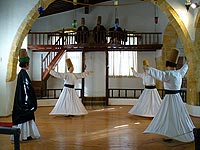
The Mevlevi Tekke (Museum of the Whirling Dervishes) in Nicosia, North Cyprus.
 |
the north cyprus travel guide |
 |
|
The Mevlevi Tekke
|
|
Beside the Kyrenia Gate in North Nicosia is the former monastery of the Mevlevi order, known as the Mevlevi dervish tekke. (The word tekke means ceremonial hall.) Today, we know the order as the Whirling Dervishes. The order lived and worshipped in these fine 17h century monastery buildings until the 1920s, when the order was officially banned. However, the distinctive building, with its low domes, was restored and opened as a museum in 1963. The Museum is well worth a visit during your holiday in Northern Cyprus, for a fascinating insight into this ancient order that we probably have heard of, yet often know so little about.
Dancing Back to the Divine; the Mevlevi dervish beliefs
The Mevlevi Islamic order followed the teachings of Celaleddin Rumi, a thirteenth century teacher who travelled extensively in Asia. Rumi wrote a famous poem based on his teachings, the "Mathnawi", in which he describes how a man’s soul may be separated from God during his life, but will be drawn back to the Divine by the power of love. The order expressed this wish to return to the Divine presence through music and dance, Followers danced and whirled to the accompaniment of a reed flute, called a "ney", during a special ceremony called a "sema".
The Museum of the Whirling Dervishes, North Nicosia
Inside, the museum devoted to the order displays the instruments played at the ceremonies, including the "ney" reed flute, a type of lute called a "oud" and the paired drums, or "kudum". It’s worth looking at the photo of the last ceremony held here, which is on the wall of the museum. You soon realise that this relatively small space would be filled with up to ten participants in the ceremony, accompanied by the musicians playing the gallery above your head and under the watchful eye of the head of the order, the "seyh". You are quite literally standing on the dance floor; the wooden floor of the museum is the original. (Just don’t try a quick spin!)
At the side of the building is a domed hall, containing tombs of those associated with the dervish order, including the last "seyd", who died in 1953. (The order now has its headquarters in Syria.)
If you get a chance to see some dervish dancers during your holiday in North Cyprus, grab the chance. It really is amazing to watch the dancers begin to slowly build up speed through small steps, and then continue turning in this dizzyingly small circle for minutes on end. As they circle round, male dancers spread out their multicoloured capes, lifting them high then dropping suddenly so they appear to be like human spinning tops. It’s astounding to watch and when it comes to an end, not one dancer is the slightest bit dizzy – amazing!
| PARTNERS |





 Advertise on this site
Advertise on this site
|
North Cyprus quick: holidays | flights | hotels | property | kyrenia | famagusta | photos | map | weather | history | news
All text is copyrighted by Cyprus44. Photographs are copyrighted by their respective photographers.
For more information read our copyright policy, privacy policy and disclaimer.
This web page is served on 17 September 2025 at 1:49:04 AM.
![]()
Cyprus44 in other languages: Nordzypern | Chypre Nord | Severní Kypr | Северный Кипр
partner sites: goNorthCyprus Travel | Pacific Rent-A-Car | Amy Holiday Villas | other partner sites

